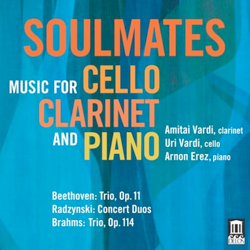by Samantha Spaccasi

The first movement of the Beethoven is marked by lush, sparkling playing from each musician. Uri Vardi performs with vibrancy, while Ami Vardi’s sweet, playful tone is on full display throughout the entire work. That playful lightheartedness is transferred to Erez, who plays the fun melody with brightness. The well-paced movement is performed with zest, and every repeated passages sounds fresh. Erez’s flourishes towards the end of the movement were especially lovely. In a mood shift, the Vardis bring a sense of dark drama to the Adagio, mixed with moments of levity and soothing piano tones from Erez, who exhibits a thrilling cadenza in the final movement. Each musician handily builds anticipation with great dynamic contrast.
Radzynski’s five Concert Duos are a recent collection of chamber pieces for cello and clarinet and tie in with the theme of musical exploration discussed in the liner notes. The work also signals a significant, more somber tonal shift in the recording. Against a haunting melody played by the clarinet, the cellist plays whirling passages of the “Polonaise” with style. The “Melody” movement is marked by gentle playing from both Vardis, creating an appropriate mood of lethargy, punctured with soft, birdlike chirps from the clarinet. A high level of energy returns in “Andalusia,” with colorful, passionate playing from both musicians. This faster movement never feels rushed, and the two create a dynamic and textured performance.
The collaborative spirit heard throughout the recording is brought to the forefront during the macabre “Valse,” where the Vardis play the eerie melody with creepiness, creating an aura of suspense. Titled “Victory March,” the final, quirky movement is highlighted by bouncy playing from each artist, who transfer the melody between each other smoothly. This expansive work shows the capability of the two performers to master many musical styles.
Erez returns for the Brahms trio, which ranges in moods from dreamy to ferocious. The musicians never overpower each other, making this music a true team effort. The first movement incorporates swings in dynamics from Uri and excellent tone color from Ami, each performer grasping the emotional depth of the work. Drawing out a sense of wistfulness and longing, the second movement features pleasant pizzicatos from Uri while Ami performs the melody with refinement. Erez plays the soaring passages with an understated elegance, capturing the softness of the work without sounding timid.
The third movement is distinguished by clean and bright playing from the clarinetist with overall steady pacing. Conveying a sense of pastoral grace, Erez interprets passages with joy. In louder sections, the blend occasionally becomes slightly muddy. The last movement showcases great phrasing from Ami and Uri, with Erez’s twinkling playing providing balance and great energy from all. The trio expertly draws out the dramatic moments and intense emotions, resulting in a multifaceted interpretation.
Though the recording does have some moments in which the balances sound unusual, this is an enjoyable, energetic CD that conveys the talents of the trio with ease.
Published on ClevelandClassical.com July 31, 2017.
Click here for a printable copy of this article



